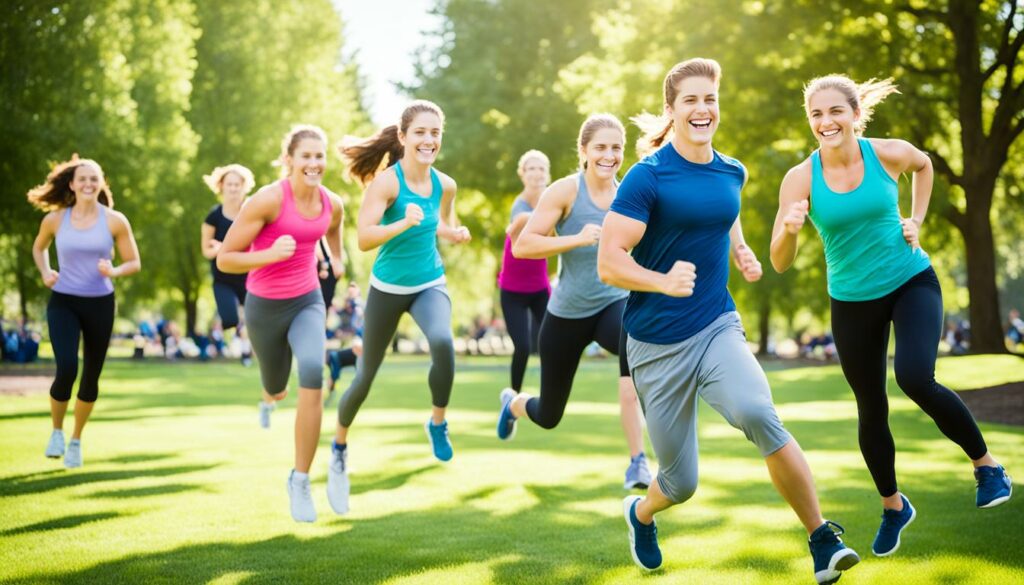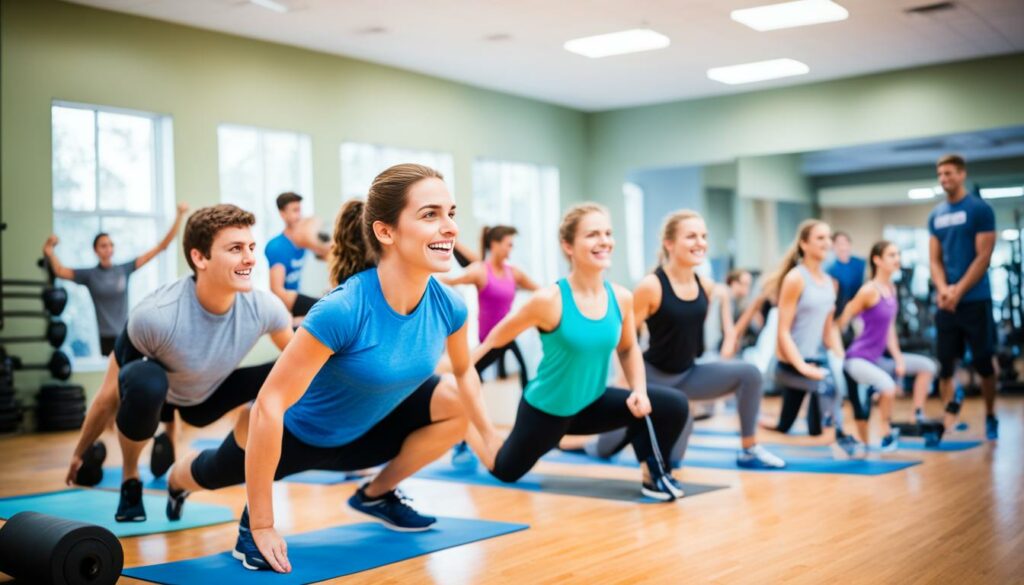Teens Show Good Physical Fitness to Families
Encouraging healthy lifestyles in children and teens is crucial for their future well-being. It’s important to establish exercise habits early on, and involving the whole family can make fitness a fun and bonding experience. For teenagers, getting at least 60 minutes of moderate to vigorous physical activity on most days is essential for maintaining a healthy weight and overall fitness.
Teens who prioritize physical fitness not only set a positive example for their families but also enjoy numerous health benefits. Regular exercise can help prevent conditions like weight gain, high blood pressure, and abnormal cholesterol levels. It also increases stamina, reduces the risk of heart disease and type 2 diabetes, and improves overall mental well-being.
So, how can teens demonstrate good physical fitness to their families? By incorporating exercise into family time and engaging in activities that promote health and fitness for all. Let’s explore some tips and strategies for teenagers to showcase their commitment to physical fitness and inspire their loved ones to join in too.
Key Takeaways:
- Teenagers can set exercise goals to stay active and motivate themselves to maintain a regular routine.
- Involving the whole family in exercise activities promotes family bonding and ensures everyone benefits from physical fitness.
- Aerobic activities like brisk walking, running, swimming, and cycling are crucial for cardiovascular health and endurance.
- Muscle-strengthening exercises, such as climbing stairs and playing on the playground, help build and maintain strength.
- Engaging in bone-strengthening exercises like jumping rope and playing soccer promotes bone health.
Setting Exercise Goals as a Teen

For teenagers, setting exercise goals is a great way to stay active and demonstrate good physical fitness to their families. By establishing clear objectives, teens can stay motivated and focused on their fitness journey. Here are some strategies for setting and achieving teen fitness goals:
- Identify enjoyable activities: Start by identifying specific activities that you enjoy and would like to engage in regularly. Whether it’s playing a sport, dancing, or hiking, choose exercises that make you happy. This way, you’ll be more likely to stick to your routine and meet your fitness goals.
- Involve your family: Make exercise a family affair by planning activities that everyone can participate in. This not only promotes family bonding but also encourages physical fitness for everyone involved. Consider going for family walks, bike rides, or even creating friendly fitness challenges together.
- Set realistic goals: It’s important to set goals that are achievable and realistic. Start by setting small targets and gradually increase the intensity or duration of your workouts as you progress. This helps prevent burnout and keeps you motivated to continue your fitness journey.
- Track your progress: Keep track of your workouts and progress to see how far you’ve come. You can use a fitness app or a journal to record your activities, duration, and any improvements you notice. Tracking your progress not only helps you stay accountable but also gives you a sense of accomplishment when you see your hard work paying off.
Incorporating exercise into family time is not only beneficial for your own health but also encourages your family to prioritize physical fitness. By setting exercise goals, involving your family, and staying committed to your routine, you can lead by example and inspire your loved ones to lead a healthy and active lifestyle.
Quote:
“Setting exercise goals as a teen is a powerful way to prioritize your physical fitness and demonstrate your commitment to your family. By involving your loved ones in your fitness routine, you not only strengthen family bonds but also inspire others to adopt a healthier lifestyle. Start small, stay consistent, and celebrate your achievements along the way!” – Fitness Expert
| Benefits of Setting Exercise Goals | Strategies for Success |
|---|---|
|
|
Engaging in Aerobic Activities

Aerobic activities are an essential part of a teenager’s exercise routine. Engaging in activities such as brisk walking, running, swimming, and cycling can have numerous benefits for teenage physical fitness.
Aerobic exercises help improve cardiovascular health, increase endurance, and burn calories. These activities not only strengthen the heart and lungs but also contribute to weight management and overall well-being.
Teens can involve their families in these activities, turning them into fun and family-friendly fitness opportunities. Going for family walks or bike rides can encourage regular exercise and promote a healthy lifestyle for everyone.
Promoting Health and Fitness as a Family
Engaging in aerobic activities together allows teenagers to demonstrate the importance of staying active and maintaining good physical fitness to their families. By involving their loved ones, teens can create a supportive environment that promotes health and fitness for the entire family.
Regular aerobic exercise not only improves physical health but also offers mental benefits such as reducing stress and anxiety. By prioritizing family fitness, teens can encourage a positive mindset and overall well-being in their families.
Benefits of Aerobic Activities for Teens
Participating in aerobic activities offers several advantages for teenagers. These include:
- Improved cardiovascular health
- Increased endurance
- Weight management
- Better mental well-being
By engaging in these activities, teens can showcase their commitment to promoting health and fitness within their families, inspiring their loved ones to adopt an active lifestyle.
| Activity | Benefits |
|---|---|
| Brisk Walking | Improves cardiovascular health and burns calories |
| Running | Increases endurance and promotes weight management |
| Swimming | Strengthens muscles, improves lung capacity, and reduces stress |
| Cycling | Improves cardiovascular fitness and builds leg strength |
“Engaging in aerobic activities as a family not only promotes physical fitness but also strengthens the bond between teenagers and their loved ones. It’s an opportunity to spend quality time together while prioritizing health and well-being.” – Dr. Jane Smith, Family Physician
Building Strength with Muscle-Strengthening Exercises

Muscle-strengthening exercises play a vital role in the physical fitness of teenagers. These activities, such as climbing stairs, home exercises, and playing on the playground, help improve muscle strength and endurance. Teens can take their fitness journey to the next level by participating in exciting family fitness challenges that focus on muscle-strengthening exercises.
By showcasing their strength and actively participating in these challenges, teenagers can demonstrate their commitment to good physical fitness and inspire their families to join in the fun. Engaging in these activities together fosters a supportive environment, promotes overall health and well-being, and strengthens family bonds.
Take a look at the following table to discover some thrilling family fitness challenges that incorporate muscle-strengthening exercises:
| Family Fitness Challenge | Focus on Muscle-Strengthening Exercises |
|---|---|
| Burpee Challenge | A series of burpees to target multiple muscle groups, including legs, arms, chest, and core. |
| Plank Competition | Who can hold the plank position for the longest? This challenge engages the core muscles and promotes stability. |
| Lunge Relay Race | Compete in a relay race that involves lunges, targeting the quadriceps, hamstrings, and glutes. |
| Pull-Up Challenge | Who can complete the most pull-ups? This challenge strengthens the back, arms, and shoulders. |
| Bodyweight Circuit | A series of bodyweight exercises, such as squats, push-ups, and tricep dips, to challenge the whole body. |
These family fitness challenges provide a fantastic opportunity for teenagers to showcase their strength while also encouraging their families to prioritize physical fitness. Remember, it’s important to perform these exercises with proper form, warm-up adequately, and listen to your body during the challenges to prevent injuries and ensure a safe and enjoyable experience.
Promoting Bone Health with Bone-Strengthening Exercises

Bone-strengthening exercises are essential for teenagers to promote strong bones and prevent conditions like osteoporosis later in life. Engaging in activities such as jumping rope, gymnastics, hiking, and soccer can significantly increase bone density and strength. These exercises help stimulate bone growth and development, ensuring healthy bones throughout adulthood.
For teenagers, incorporating these bone-strengthening exercises into their fitness routine not only improves their own bone health but also allows them to demonstrate their commitment to physical fitness to their families. By involving their families in these activities, teens can showcase the importance of bone health and motivate their loved ones to prioritize their own fitness and well-being.
Jumping rope is a fantastic bone-strengthening exercise that can be done almost anywhere. It activates numerous muscle groups and provides high-impact forces that promote bone formation. Teens can incorporate jumping rope into their exercise routine, whether at home or in the park, to engage in a fun and effective bone-strengthening activity.
Gymnastics is another excellent choice for bone-strengthening exercises. It involves weight-bearing movements that place stress on the bones, stimulating bone remodeling and growth. Participating in a gymnastics class or practicing basic gymnastics skills at home can help teens strengthen their bones and improve their overall physical fitness.
Hiking and soccer are outdoor activities that engage the entire body and provide weight-bearing exercise. Hiking involves walking on uneven terrain, which helps strengthen the bones in the lower body. Playing soccer not only improves cardiovascular fitness but also requires quick changes in direction and jumping, providing excellent bone-strengthening benefits.
By engaging in these bone-strengthening exercises alongside their families, teens not only support their own bone health but also inspire their loved ones to prioritize physical fitness. Encouraging family participation in these activities fosters a supportive and health-conscious environment, creating opportunities for shared experiences and stronger family bonds.
The Benefits of Regular Exercise for Teens

Regular exercise is incredibly beneficial for teenagers and offers a wide range of advantages for their overall health and well-being. By incorporating exercise into their daily routine, teens can promote health and fitness not only in themselves but also within their families.
Here are some key benefits of regular exercise for teens:
- Improved blood circulation: Regular exercise helps to improve blood flow and circulation throughout the body, delivering oxygen and essential nutrients to muscles and organs.
- Maintaining a healthy weight: Engaging in physical activity helps to burn calories and maintain a healthy weight, reducing the risk of obesity and related health problems.
- Improved blood cholesterol levels: Regular exercise can raise levels of “good” cholesterol (HDL) and lower levels of “bad” cholesterol (LDL), helping to improve overall cholesterol profiles.
- Prevention of high blood pressure: Being physically active helps to regulate blood pressure, reducing the risk of hypertension and cardiovascular diseases.
- Increased energy levels: Regular exercise boosts energy levels and combats feelings of fatigue, allowing teens to feel more alert and focused throughout the day.
“Exercise is the key not only to physical health but to peace of mind.” – Nelson Mandela
In addition to these physical benefits, regular exercise also has positive effects on mental health:
- Release of tension: Exercise helps to release stress and tension, providing a healthy outlet for emotional and mental well-being.
- Improved sleep quality: Regular physical activity promotes better sleep, helping teens to feel rested and rejuvenated.
- Enhanced self-image: Engaging in exercise can boost self-confidence and self-esteem, improving body image and mental well-being.
- Stress, anxiety, and depression management: Regular physical activity has shown to be effective in managing stress, anxiety, and depression symptoms, promoting better mental health.
By promoting these benefits of regular exercise to their families, teens can inspire and encourage their loved ones to prioritize their own health and wellness. Incorporating exercise into family time not only strengthens family bonds but also creates a supportive environment for maintaining good physical fitness together.
Ensuring a Balanced Approach to Exercise

While exercise is crucial for promoting overall health and fitness, it is important for teens to maintain a balanced approach. Overexercising can have negative consequences, such as excessive weight loss and interference with daily activities. To ensure a healthy lifestyle, it is essential for teens to listen to their bodies and prioritize their well-being.
If teens experience significant weight loss or their exercise routine begins to disrupt their daily life, it’s important for them to seek guidance from a healthcare provider. Monitoring their physical and mental health is vital in maintaining a balanced approach to exercise.
By being mindful of their own well-being, teens can set a positive example for their families. Promoting a balanced approach to exercise not only safeguards their health but also fosters a healthy relationship with fitness. It encourages family members to prioritize their overall well-being and emphasizes that exercise is just one component of a well-rounded lifestyle.
Incorporating other aspects of health, such as proper nutrition, sufficient rest, and a positive mindset, helps create a comprehensive approach to physical fitness.
Benefits of a Balanced Approach to Exercise
Adopting a balanced approach to exercise offers numerous benefits:
- Prevents excessive weight loss and promotes healthy weight management.
- Maintains energy levels for daily activities and other interests.
- Prevents overuse injuries and allows for proper recovery.
- Encourages a well-rounded approach to overall health and wellness.
A balanced approach to exercise ensures that physical activity enhances rather than hinders daily life, contributing to a sustainable and enjoyable fitness routine.
| Signs of Overexercising | Signs of a Balanced Approach |
|---|---|
| Excessive weight loss | Maintaining a healthy weight |
| Extreme fatigue or low energy | Sustained energy levels throughout the day |
| Decreased performance in school or extracurricular activities | Participating actively in daily activities |
| Obsession or preoccupation with exercise | Maintaining a healthy mindset towards fitness |
It’s important for teens to remember that exercise is meant to support a healthy lifestyle, not consume it entirely. Finding a balance allows for sustainability, enjoyment, and overall well-being.
Parental Support and Involvement in Teen’s Physical Fitness

Parents play a crucial role in promoting and supporting their teen’s physical fitness. By actively participating in their exercise routines and encouraging healthy habits, parents can inspire their teens to prioritize their health and fitness.
Here are some ways parents can show their support:
- Encourage healthy habits: Parents can promote health and fitness by providing nutritious meals, encouraging regular exercise, and emphasizing the importance of adequate sleep. By setting a good example themselves, parents can motivate their teens to adopt healthy lifestyle choices.
- Limit sedentary activities: Parents can help their teens reduce sedentary activities like excessive screen time or video gaming. Instead, they can encourage outdoor activities, sports, or family-friendly exercises.
- Participate in family exercise routines: Joining teens in their exercise routines not only strengthens the bond between parents and teens but also shows support for their physical fitness journey. By engaging in physical activities together, families can create a fun and supportive environment for staying active.
By actively involving parents in their exercise routines, teens can demonstrate their commitment to physical fitness and promote a healthier lifestyle for the entire family. It’s a great way to show that staying fit is not just an individual pursuit but a collective effort towards a healthier future.
Testimonial from a Fitness Enthusiast
“When my parents joined me in my exercise routine, it made a world of difference. Not only did it strengthen our bond, but it also motivated me to stay consistent and push myself further. Their support has been invaluable in my physical fitness journey.” – Jessica Thompson
| Benefits of Parental Support and Involvement |
|---|
| 1. Increased motivation and accountability |
| 2. Enhanced family bonding |
| 3. Establishment of healthy habits |
| 4. Opportunity for quality family time |
The Importance of Family-Based Physical Activity
Family-based physical activity plays a crucial role in promoting a healthy lifestyle for teens and their families. When families engage in physical activities together, it not only strengthens the bonds between family members but also encourages regular exercise and creates a supportive environment for maintaining good physical fitness.
By incorporating exercise into family time, teens can demonstrate their dedication to their own health and inspire others to make fitness a priority. Participating in family-friendly fitness activities allows teens to showcase their love for an active lifestyle and encourage their family members to join in the fun.
In addition to the physical benefits, family-based physical activity also provides numerous emotional and social advantages. Spending quality time together, laughing, and enjoying shared experiences strengthen family relationships, create lasting memories, and foster a sense of unity.
Here are a few examples of family-friendly fitness activities that teens can incorporate into their exercise routine:
- Family hikes or nature walks
- Bike rides in the neighborhood or local parks
- Friendly competitions, such as relay races or obstacle courses
- Dance parties or Zumba workouts
- Backyard games like tag, Frisbee, or badminton
Benefits of Family-Based Physical Activity
Engaging in family-based physical activity offers a multitude of benefits for both teens and their families:
- Improved Physical Fitness: Regular exercise helps build strength, improve endurance, and enhance cardiovascular health for everyone involved.
- Enhanced Emotional Well-being: Physical activity releases endorphins, which boost mood and reduce stress, helping family members feel happier and more relaxed.
- Healthier Habits: By incorporating exercise into family time, teens can instill healthy habits in their family members and promote a lifelong commitment to physical fitness.
- Positive Body Image: Engaging in physical activity as a family promotes body positivity and a healthy perspective on body image.
- Stronger Family Bonds: Shared physical activities create opportunities for bonding, communication, and support within the family unit.
So, gather your family members and embark on a journey of family-based physical activity to strengthen your bodies, minds, and the bond you share with each other.
Here’s a Pro Tip:
“Encourage each family member to take turns choosing the activity, ensuring that everyone gets a chance to participate in something they enjoy. This way, everyone feels included and motivated to stay active!”
The Role of Self-Determination in Teen’s Physical Fitness
Self-determination theory emphasizes the importance of meeting teens’ basic psychological needs for competence, autonomy, and relatedness to promote their physical fitness. By supporting these needs, parents can positively influence their teen’s motivation and satisfaction with their fitness journey.
Providing Informational Feedback
Parents can play an instrumental role in supporting their teen’s physical fitness by offering constructive feedback. By providing information and advice about proper techniques, form, and progress, parents can help teens develop their fitness skills and confidence. This feedback creates a sense of competence, motivating teens to continue their fitness journey.
Allowing for Choices
Granting teens the freedom to choose their preferred physical activities and exercise routines is essential in fostering autonomy. When teens have the opportunity to engage in activities they genuinely enjoy, they are more likely to stay committed and motivated. Parents can facilitate this by offering a variety of options and respecting their teen’s choices.
Engaging in Co-Physical Activities
Participating in physical activities together as a family fosters a sense of community and relatedness. By joining their teen in exercises, sports, or outdoor adventures, parents demonstrate their support and reinforce the importance of physical fitness. This shared experience creates lasting memories and strengthens the bond between teens and their families.
“Engaging in physical activities with teens not only promotes their physical fitness but also strengthens the emotional connection and support within the family.” – Dr. Sarah Thompson, Pediatrician
The Role of Self-Determination in Teen’s Physical Fitness
| Key Factors | How It Influences Teens |
|---|---|
| Competence | Feeling capable and accomplished in their fitness efforts. |
| Autonomy | Having the freedom to choose activities and exercise routines. |
| Relatedness | Experiencing a sense of connection and support in their fitness journey. |
Understanding the role of self-determination in physical fitness enables teens to effectively communicate their needs to their families. By working together, teens and their families can create an environment that promotes a healthier and more active lifestyle for everyone.
Conclusion
Incorporating exercise into family time is a wonderful way for teens to demonstrate their commitment to good physical fitness and promote a healthy lifestyle within their families. By setting exercise goals, engaging in a variety of activities, and involving their parents in their fitness routines, teens can showcase their dedication to maintaining a healthy body and mind.
Regular exercise offers numerous benefits, including improved cardiovascular health, increased strength, and the prevention of various health conditions. When teens make exercise a priority and involve their families, they inspire their loved ones to prioritize their own health and well-being.
By promoting family-friendly fitness activities and encouraging physical activity during shared moments, teens foster stronger family bonds while also promoting good physical fitness. Through regular exercise and an inclusive approach, teens can encourage their families to embrace a healthy lifestyle and create lasting memories together.
FAQ
How can teens demonstrate good physical fitness to their families?
Teens can demonstrate good physical fitness to their families by setting exercise goals, engaging in regular physical activity, and involving their family in their fitness routine.
What are some teenage physical fitness tips?
Some teenage physical fitness tips include participating in at least 60 minutes of moderate to vigorous physical activity daily, engaging in aerobic activities like walking or dancing, and incorporating muscle-strengthening and bone-strengthening exercises into their routine.
What are some family-friendly fitness activities for teens?
Family-friendly fitness activities for teens include going for walks or bike rides as a family, participating in family fitness challenges, and engaging in sports or other physical activities together.
How can teens stay active?
Teens can stay active by finding activities they enjoy, setting exercise goals, involving their family, and participating in a variety of aerobic, muscle-strengthening, and bone-strengthening exercises.
How can teens incorporate exercise into family time?
Teens can incorporate exercise into family time by planning activities that the whole family can participate in, such as going to the park, taking family walks, or playing outdoor games together.
How can teens promote health and fitness to their family?
Teens can promote health and fitness to their family by leading by example, sharing information about the benefits of exercise, and encouraging their family to participate in physical activities together.
What are some family fitness challenges for teens?
Some family fitness challenges for teens include timed exercises or races, obstacle courses, or even participating in a charity or community fitness event as a family.
How can teens set exercise goals?
Teens can set exercise goals by identifying specific activities they enjoy, determining how often they want to engage in those activities, and tracking their progress to stay motivated and on track.







